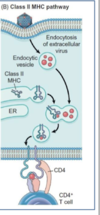Lecture 5: Antiviral immunity and Prophylaxis Flashcards
What are the parts of the innate immune system? Adaptive immune system?
- Innate immunity: Natural barriers, IFN, NK, Macrophages.
- Adaptive immunity: Cytotoxic T cells, antiviral antibodies, helper T cells
Where are B cells made in the bird?
Bursa of fabricius
What antibody is present mainly in the mucus membranes? What about near the alveoli?
MM: IGA is present here mostly.
IgG is alveoli areas
What size of foreign antibodies can pass through the nose, bronchi, bronchioles, alveoli?
- Foreign antigen through nose 15 mcL
- Bronchi : 10 mcL
- Bronchioles: 5 mcL
- Alveoli: 1 mcL

What are the stages of phagocytosis?
- Stages of phagocytosis
- CAID -> Chemotaxis -> adherence -> Ingestion -> Destruction

What is the purpose of IFN’s? Are IFN’s specific to viruses? What about cell specific? Species specidic?
- IFN -> Chemical produced by viral infected cells to alert for response to viral infections.
- IFNs not virus specific but cell specific in production and effects and is Species specific.
What are IFN’s? What can inactivate them?
- Glycoprotein’s, stable at ph2 and resistant at 56 degrees c for 1 hour
- Can be inactivated by treatment with proteolytic enzymes.
What is the purpose of developing a fever when sick? What does the fever mean?
- Fever helps induce immune response.
- Fever is important. It is synthesizing the immune response. The more fever the larger the immune response. The fever will trigger IFN when it gets above 40 degrees c
Which IFN has the most genes that encode it?
- IFN-a : 20 genes incode this
- 1 gene encodes Beta and gamma
What is the definition of an IFN?
IFNs: sets of proteins released by the virus infected cells which react with the surrounding non infected cells rendering them resistant to this type of viral infection
What are type 1 IFNs?
IFN alpha (leukocyte IFN (monocytes) B lymphocytes)
IFN beta (fibroblast IFN, Epithelial cells)
What are type 2 IFNs?
IFN gamma
(Immune IFN ( some activated t cells, NK cells)
What are IFN inducers?
- Infectious or inactivated virus induce the production of IFNs for 20-50 hrs after exposure
- Viruses that might multiply slowly and not damage the cell or the synthesis of protein early are good IFN inducers
- Cells of bone marrow, spleen, and macrophages are highly IFN producers
- Polynucleotides (Poly-IC) are good IFN inducers
What is the antiviral mechanisms induced by IFNs?
- 1.Block viral mRNA synthesis
- 2.Block the translation of viral mRNA

How does antigen processing/ display occur with MHC - I Molecules?
Viral peptides are produced from proteins in the cytosol and transported to the ER to bind to Class I MHC complex
The peptide/Class I MHC complex transported to the cell surface and displayed for recognition by the CD8+











